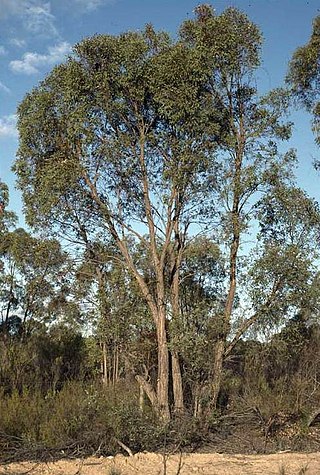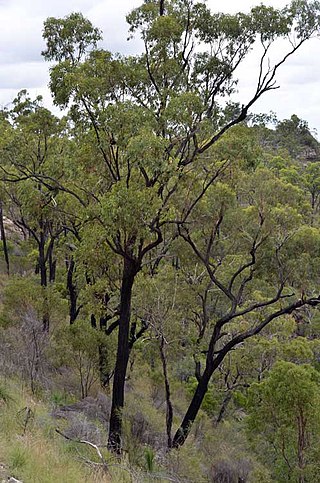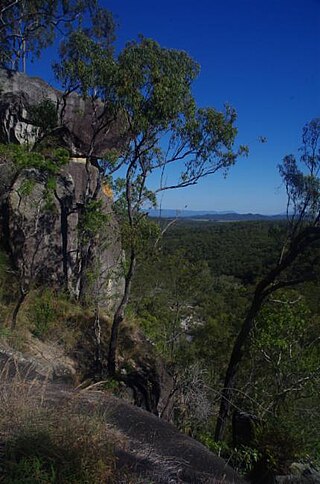
Eucalyptus crebra, commonly known as the narrow-leaved ironbark, narrow-leaved red ironbark or simply ironbark, and as muggago in the indigenous Dharawal language, is a species of small to medium-sized tree endemic to eastern Australia. It has hard, rough "ironbark" from its trunk to small branches, linear to lance-shaped adult leaves, flower buds in groups of seven, nine or eleven, white flowers and cup-shaped, barrel-shaped or hemispherical fruit. A variable species, it grows in woodland and forest from the Cape York Peninsula to near Sydney. It is an important source of nectar in the honey industry and its hard, strong timber is used in construction.

Eucalyptus fibrosa, commonly known as the red ironbark, broad-leaved red ironbark or broad-leaved red ironbark, is a species of medium-sized to tall tree endemic to eastern Australia. It has grey to black ironbark, lance-shaped to egg-shaped adult leaves, flower buds in groups of between seven and eleven, white flowers and conical fruit.

Eucalyptus melanophloia, commonly known as silver-leaved ironbark, is a species of tree that is endemic to northeastern Australia. It is a small to medium-sized tree with rough, hard ironbark on the trunk and branches. The crown is usually composed of juvenile leaves that are dull, glaucous, sessile and arranged in opposite pairs. The flower buds are arranged in groups of seven, the flowers white and the fruit cup-shaped to hemispherical.

Eucalyptus melliodora, commonly known as yellow box, honey box or yellow ironbark, is a species of medium-sized to occasionally tall tree that is endemic to south-eastern, continental Australia. It has rough, flaky or fibrous bark on part or all of the trunk, smooth greyish to yellowish bark above. The adult leaves are lance-shaped to egg-shaped, the flower buds are arranged in groups of seven and the fruit is more or less hemispherical.

Eucalyptus caliginosa, commonly known as broad-leaved stringybark or New England stringybark, is a tree that is endemic to eastern Australia. It has stringy bark, lance-shaped or curved adult leaves, flower buds in groups of seven or nine, white flowers and more or less hemispherical fruit. It is common on the Northern Tablelands and North West Slopes of New South Wales and adjacent areas of Queensland.

Eucalyptus moorei, commonly known as narrow-leaved sally, is a species of mallee that is endemic to New South Wales. It has smooth bark, linear to narrow lance-shaped or curved adult leaves, flower buds in groups of between seven and fifteen, white flowers and cup-shaped or shortened spherical fruit.

Eucalyptus tenella, commonly known as narrow-leaved stringybark, is a species of small to medium-sized tree that is endemic to New South Wales. It has stringy bark, narrow lance-shaped to linear leaves, flower buds in group of seven to fifteen, white flowers and hemispherical fruit.

Eucalyptus beyeriana, commonly known as Beyer's ironbark, is a small tree that is endemic to New South Wales. It has dark grey to black "ironbark", lance-shaped adult leaves, flower buds in groups of seven, white flowers and cup-shaped to conical or shortened spherical fruit. Its name is disputed with some authors considering it to be a synonym of Eucalyptus beyeri.

Eucalyptus panda, commonly known as tumbledown ironbark or Yetman ironbark, is a species of small to medium-sized tree that is endemic to eastern Australia. It has dark ironbark, linear to lance-shaped adult leaves, flower buds in groups of seven, white flowers and cup-shaped or hemispherical fruit.
Eucalyptus indurata, commonly known as ironbark or ironbark mallee, is a species of tree or mallee that is endemic to southern Western Australia. It has rough, hard, blackish, furrowed bark on the trunk, smooth whitish bark above, lance-shaped adult leaves, flower buds in groups of seven, white to pale yellow flowers and shortened spherical fruit.

Eucalyptus latens, commonly known as narrow-leaved red mallee, is a species of mallee that is endemic to the south-west of Western Australia. It has smooth grey and coppery bark, linear to narrow lance-shaped adult leaves, flower buds in groups of seven to eleven or more, creamy white flowers and small barrel-shaped to shortened spherical fruit.

Eucalyptus rigidula, commonly known as stiff-leaved mallee, is a species of mallee that is endemic to Western Australia. It has smooth bark, linear to narrow elliptic or narrow lance-shaped leaves, flower buds in groups of nine or eleven, creamy white flowers and barrel-shaped to hemispherical fruit.

Eucalyptus tenuipes, known as the narrow-leaved white mahogany, is a species of small tree that is endemic to Queensland. It has rough, fibrous bark, narrow lance-shaped leaves arranged in opposite pairs, flower buds in group of eleven to twenty, white flowers and spherical to hemispherical fruit.
Eucalyptus atrata, commonly known as the Herberton ironbark or blue-leaved ironbark, is a small tree that is endemic to Queensland. It has hard, black "ironbark" on the trunk and all but the thinnest branches, lance-shaped adult leaves, buds usually arranged in groups of seven, white flowers and cup-shaped to hemispherical fruit. It is characterised by the blue-grey, powdery bloom on its leaves and flower buds.

Eucalyptus beaniana , commonly known as the Bean's ironbark, is a small tree that is endemic to Queensland. It has rough, furrowed "ironbark" on the trunk and branches, dull green to bluish, lance-shaped to curved adult leaves, flower buds in groups of seven, white flowers and cup-shaped to conical fruit. It is only known from four locations in southern inland Queensland.
Eucalyptus cullenii, commonly known as Cullen's ironbark, is a species of small to medium-sized tree that is endemic to Queensland. It has thick, rough, deeply furrowed "ironbark", lance-shaped adult leaves, green to yellow flower buds in groups of seven, white flowers and hemispherical fruit.

Eucalyptus granitica, commonly known as the granite ironbark, is a species of tree that is endemic to Queensland. It has dark grey or black "ironbark" on the trunk and branches, glossy green, lance-shaped to curved adult leaves, flower buds in groups of seven, white flowers and cup-shaped to barrel-shaped fruit.

Eucalyptus virens, commonly known as the shiny-leaved ironbark, is a species of small to medium-sized tree that is endemic to Queensland. It has hard ironbark on the trunk and branches, narrow lance-shaped adult leaves, flower buds in groups of seven, white flowers and hemispherical fruit.
Eucalyptus elegans is a species of tree that is endemic to eastern Australia. It has rough bark throughout, linear to narrow lance-shaped or curved adult leaves, flower buds arranged in groups of between three and seven, white flowers and cup-shaped fruit.
Eucalyptus farinosa is a species of small tree that is endemic to Queensland. It has hard, dark grey ironbark, egg-shaped to lance-shaped adult leaves, flower buds in groups of seven, white flowers and cup-shaped to barrel-shaped and ribbed fruit.














